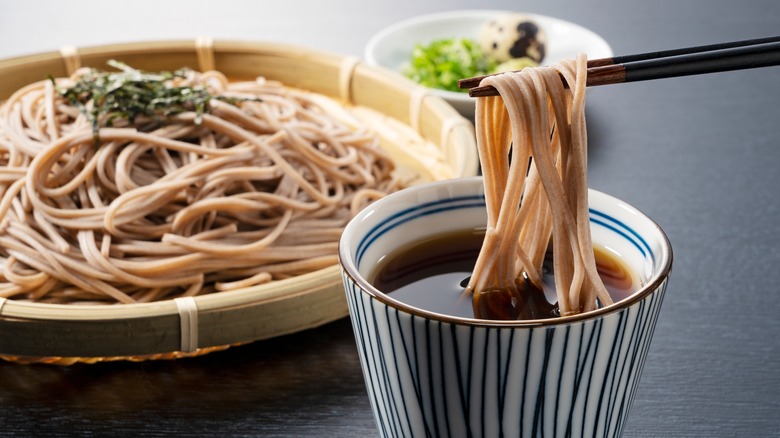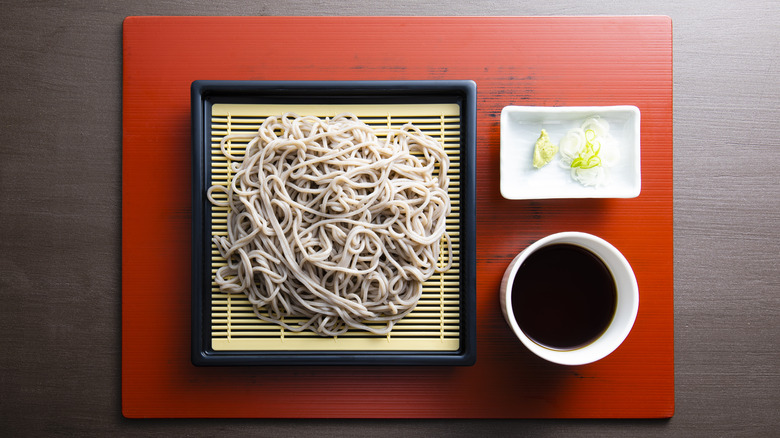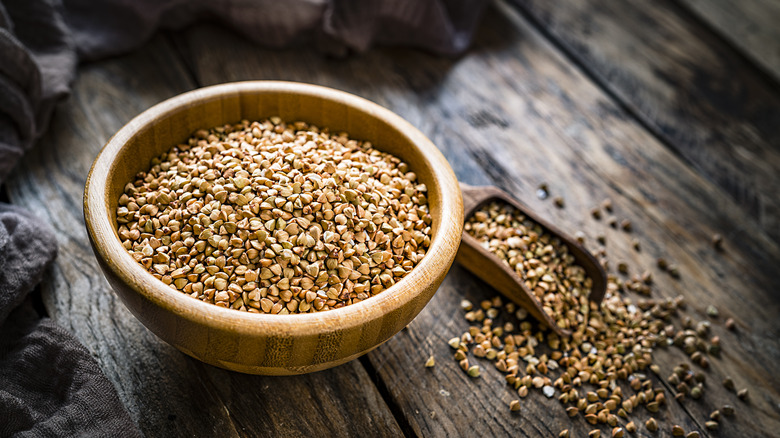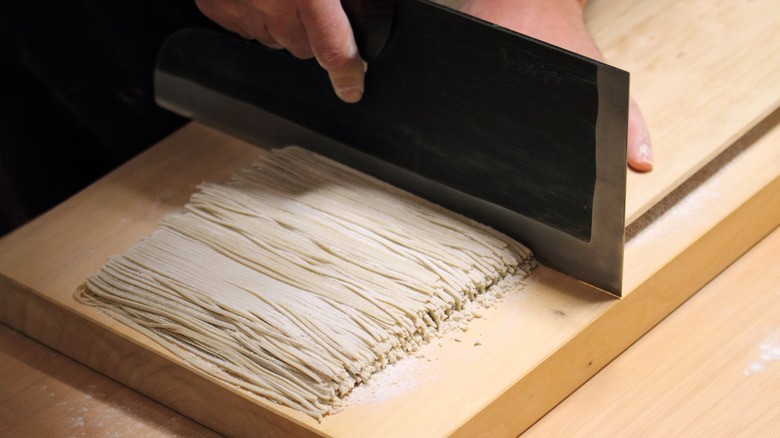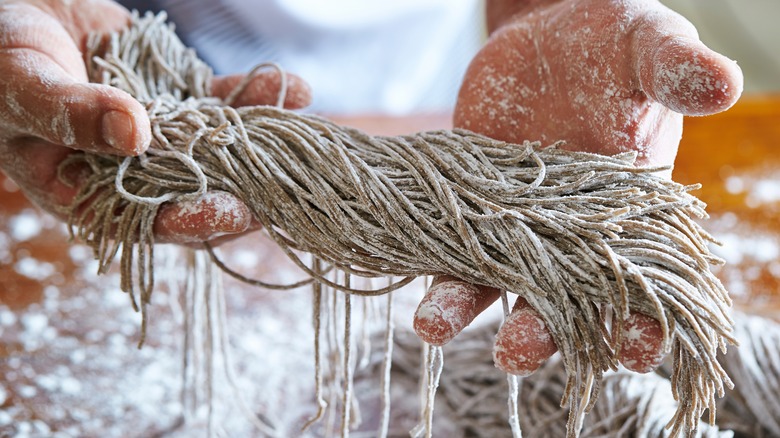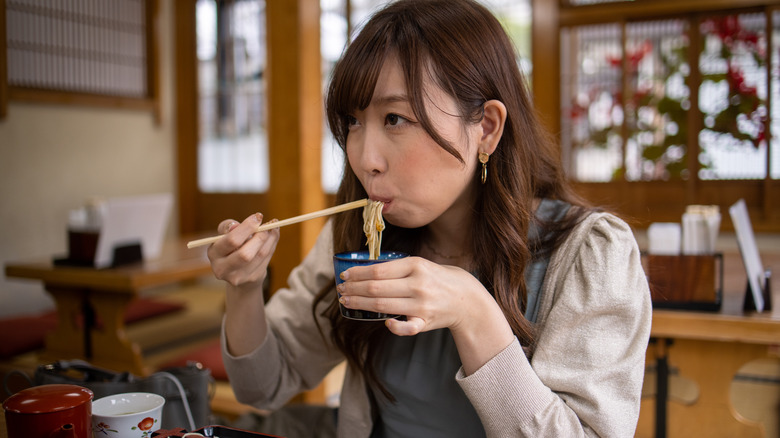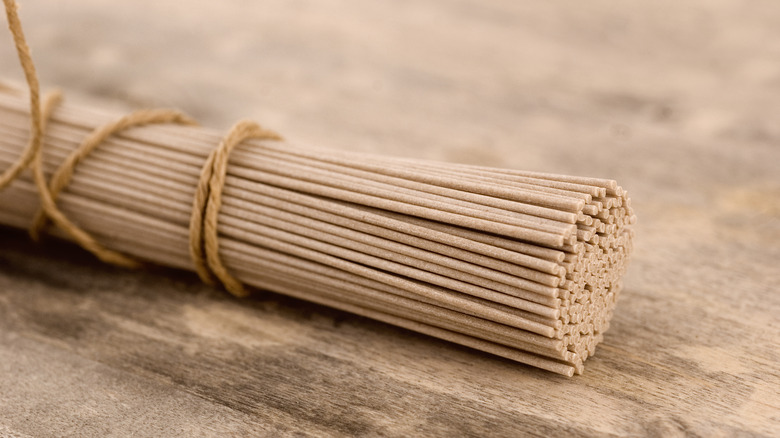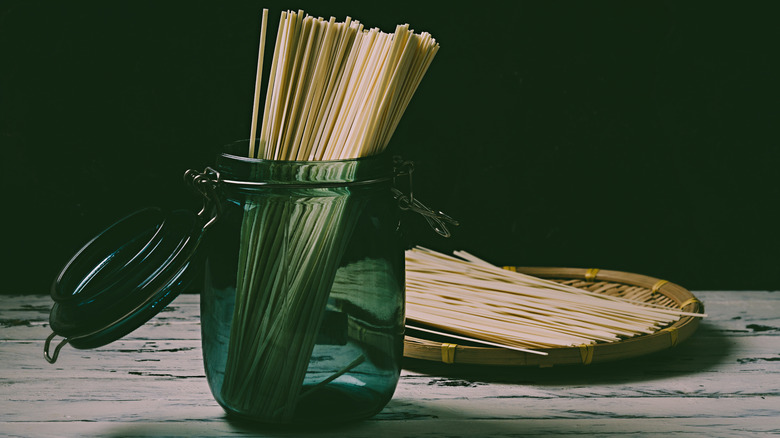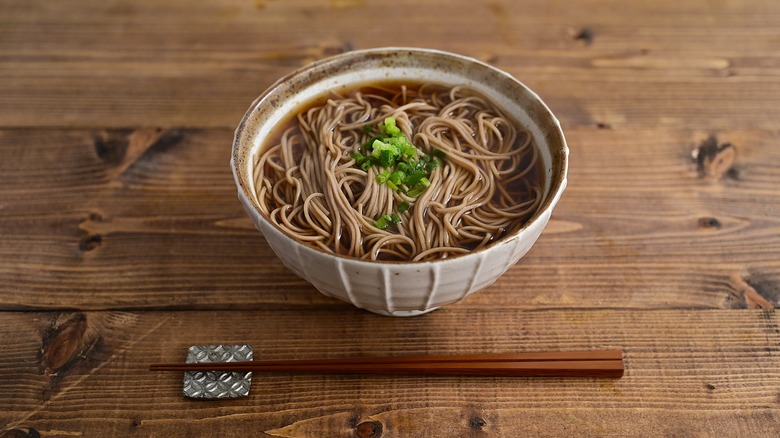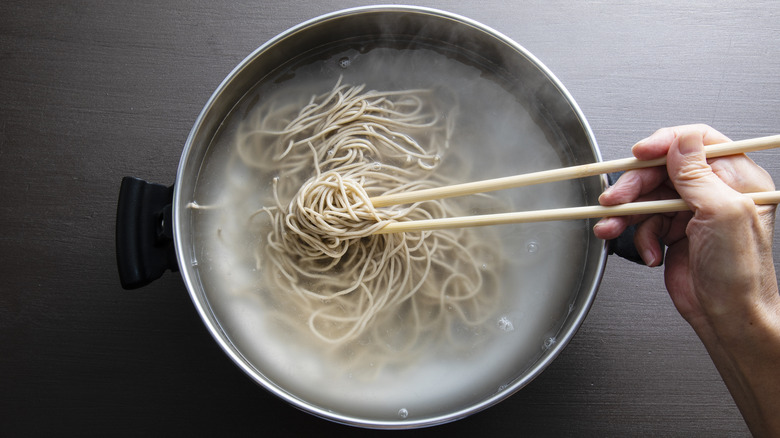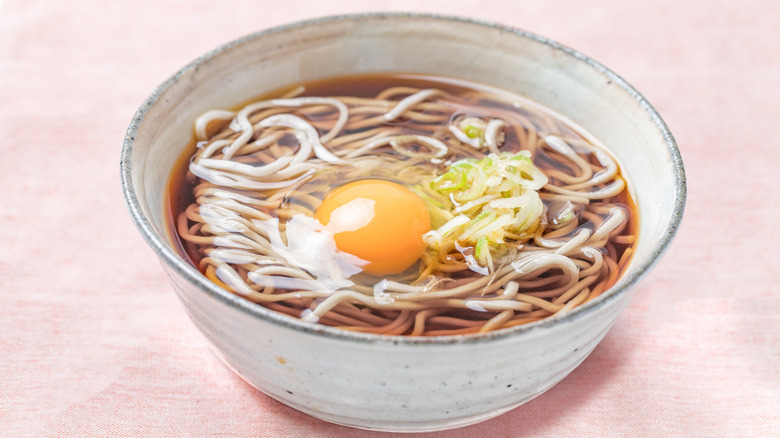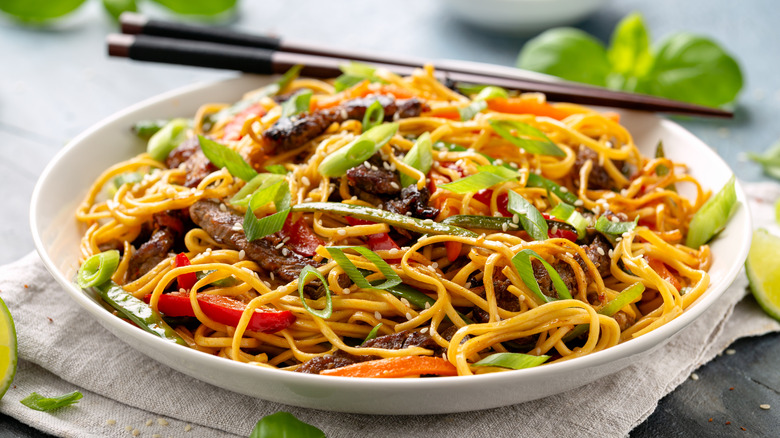What Are Soba Noodles And How Do You Use Them?
If you think noodles are noodles and there's really not much difference between any of them, you're sorely mistaken. Soba noodles are just one of dozens of types of noodles. And that list gets even longer if you include pasta noodles. But today it's soba noodles that are taking their turn in the spotlight. Maybe you've heard of them but aren't quite sure what they're all about, or perhaps you've never even read the name "soba" before. Either way, you're about to learn more.
Soba noodles have a long history in Japanese cuisine. And once you get past that, there are even more interesting facts about them. For instance, they're made from buckwheat, rather than the usual wheat or rice flour. It can take decades to completely perfect the art of making soba noodles by hand. But that's just the tip of the iceberg. We're about to take a journey into soba noodles and you're coming along for the ride.
From their origins to how to cook them, and how to store them, there's lots to learn about these tasty noods. By the time you've finished reading, you'll know all about soba noodles and how to use them.
What's the history of soba noodles?
Soba noodles have a long history. Much longer than the noodles themselves. Their origins can be said to date back to the Mesolithic period (the period between 8000 B.C. and 2700 B.C.), when buckwheat was introduced to Japan from China. However, this is only the beginning of the story.
At first, buckwheat was only used to make porridge in Japan. It wasn't until it became easier to mill buckwheat into flour that sobagaki were first made. These are a precursor to soba noodles. They're effectively buckwheat flour dumplings and likely came before noodles because they're easier to make. They were first mentioned in ancient Japanese writings.
The first mention of someone eating soba noodles as we know them today was in 1614. This was during the Edo period in Japan. It was mentioned in the diary of a monk called Jisho of the Sonshoin Temple in Kyoto. However, it's likely that soba noodles have been enjoyed for longer than this. So while there might not be a precise date recorded for the invention of soba noodles, they've been eaten in Japan for hundreds of years and they're still popular today.
What are soba noodles made of?
As we touched on above, soba noodles are made from buckwheat. Despite its name, buckwheat is not a type of wheat and is not related to wheat at all. In fact, it's gluten-free, so soba noodles made entirely out of buckwheat flour are suitable for celiacs and those with gluten intolerances.
But not all soba noodles are made just from buckwheat. There are two main types of soba noodles: juwari soba and nihachi soba. Juwari soba is the original type of soba. This is made from nothing but buckwheat flour and water. Nihachi soba is a slightly later invention. This contains a mixture of 80% buckwheat flour and 20% wheat flour. Some nihachi soba noodles include other ingredients as binders, including eggs, seaweed, and konjac starch.
While some soba purists believe that juwari soba is the only way to go, nihachi soba dates back to the 1600s, so it also has a long history. It was invented to make soba-making easier. Without the addition of wheat flour, there's no gluten in the dough. This means it falls apart easily, as it doesn't contain those long gluten strands to help hold it together. The invention of nihachi turned soba-making into a process that was less arduous and prone to failure.
It's also worth noting that water quality is traditionally important. Some top producers only use natural mineral water or will only use water from Kyoto, which is thought to be the purest in Japan.
How are soba noodles made?
Learning to make soba noodles by hand isn't easy. Professional soba chefs can train for up to 10 years to learn their craft. However, once you know how to make soba noodles by hand, it only takes about 20 minutes. The process involves mixing dough from buckwheat flour and water before rolling it thin by hand. Once it's thin enough, the soba noodle dough is folded into layers and cut into noodles.
Of course, if you buy soba noodles from the store, they won't have been crafted this way. But that's okay. They might not be the best soba of your life, but they'll still be reliably decent. Commercially produced soba noodles are made using a similar process of mixing, rolling, and cutting, but it's done using machinery, not by hand. Commercial noodles are also dried before being packaged to extend their shelf life.
As we've touched on, the dough can be made either just from buckwheat flour and water or from a mixture of flour and buckwheat flour. The traditional ratio for the latter type of noodles is four parts buckwheat flour to one part wheat flour. However, you'll often see commercial soba noodles with significantly less buckwheat flour. This makes them easier to process but means they lose that authentic buckwheat flavor. Look for noodles with a dark gray-brown hue. If they contain a small amount of buckwheat, they'll be much more pale.
Can you make soba noodles from scratch?
Yes, you absolutely can make soba noodles from scratch. But given that the best soba noodle makers in Japan train for years to learn their craft, you should expect a few missteps along the way. You can find recipes for making soba noodles by hand online if you want to give it a go, but let's go over the basics.
You start by making a dough from buckwheat flour and water. Not all buckwheat flour works for soba noodles, but Anson Mills and Cold Mountain buckwheat flours are both up to the task — and available in the U.S. While you can try 100% buckwheat flour, as a beginner, you'll probably have much more luck making nihachi soba noodles with around 20% wheat flour, to help with binding. Once you've made the dough, you can either roll it with a rolling pin or a pasta machine. The latter is less authentic but will make the process easier.
After cutting your noodles, you just need to boil them for 60 seconds to cook them. They have such a great flavor and texture compared to the soba noodles found dried in grocery stores that they only need simple preparation. Serve them in some dashi broth with a little soy sauce for a simple yet truly delicious meal.
What do soba noodles taste like?
Not tried soba noodles? Then you might be wondering what they taste like. What makes soba noodles notable is how different they taste from other types of noodles. While noodles made from rice flour and wheat flour have a fairly neutral flavor, soba noodles have a distinct flavor from buckwheat flour.
This flavor is often described as nutty or earthy, but you really have to try them to find out exactly what they taste like. Some people love the flavor of buckwheat, while others aren't huge fans of its characteristic taste. Whether or not you end up being a buckwheat fan, one thing you need to consider when deciding what to eat your noodles with is that the strong taste can compete with other flavors. They're not the kind of noodles that are best eaten with other robust flavors like satay sauce. Rather, try pairing them with less pronounced flavors such as cucumber, nori, dashi stock, and spring onions.
Where can you buy soba noodles?
Now that you know more about soba noodles, you might be wondering where you can buy them. If you want to buy noodles to cook at home, they're fairly easy to find. You'll be able to buy soba in most well-stocked grocery stores. In fact, check out the noodle section and you'll usually have at least a couple of soba noodle brands and varieties to choose from. Of course, this can vary depending on where you live and what grocery stores you tend to shop in. For instance, you might not find them at Aldi, but you should be able to pick them up at Walmart or Trader Joe's.
But not all soba noodles are created equal. If you're searching for the best grocery store brand, consider noodles made by Shirakiku, Kabuto, or Wei-Chuan. However, you'll often find higher-quality noodles at Asian grocery stores. If you have one in your area, check out a Japanese grocery store. If not, many large Chinese or Korean grocery stores will sell a large range of soba noodles. If you're lucky, you may be able to find fresh soba noodles for sale at some Asian markets.
If you're desperate to try fresh, handmade soba noodles, look for a Japanese restaurant that makes its own noodles. These aren't all that common outside Japan, but you may have luck in bigger cities.
How do you store soba noodles?
Once you've procured them, how do you store your soba noodles to keep them fresh? First, let's look at dried soba noodles. You should store them in a pantry or other cool, dry place, much like you'd store rice or pasta. On average, dried soba noodles last for around a year, but you should check the packaging to find their best-before date. Note that this is just a guideline. If they've passed their best-before date but still look fresh and smell good, they're probably fine to eat. Once you've opened the packet, it's best to store any leftover dried noodles in an airtight container to keep moisture and bugs out.
If you manage to get your hands on fresh, uncooked soba noodles or you make them yourself, they will last for one to three days in the fridge. To keep them from drying out, put them in an airtight container along with a wet paper towel.
But, what about cooked soba noodles? For the best flavor and texture, you should eat them right away. However, they'll stay fresh in your fridge in an airtight container for up to three days. You should rinse them with cool water after cooking to prevent them from clumping and sticking together in the fridge. However, make sure to carefully drain off any excess liquid, as it can cause soba noodles to go soggy or mushy. This can ruin their texture when you reheat them.
What's the nutritional value of soba noodles?
You might be wondering if soba noodles are good for you. If you're trying to diversify the starches you eat, they're a great choice. Good soba noodles are predominantly made from buckwheat flour. But what is buckwheat and is it a nutritious ingredient to eat? Buckwheat is a grain-like seed — and, according to Medical News Today, it may be beneficial for heart health. Since buckwheat is gluten-free, soba noodles made without any added wheat flour are great for people with gluten sensitivities or celiac disease.
But let's delve further into nutritional value. According to Healthline, every 2 ounces of 100% buckwheat soba noodles contain 8 grams of protein and 3 grams of fiber. It also contains a range of vitamins and minerals, including thiamine, niacin, iron, magnesium, and manganese. The nutritional value of soba noodles is roughly on par with whole-wheat spaghetti. So if you're looking to include more whole grains and seeds in your diet, eating more soba noodles is an easy — and delicious — way to do so.
Buckwheat also has a low glycemic index, which means that it affects your blood sugar less. So it can help to avoid blood sugar spikes when managing diabetes. Plus, even for those who don't have diabetes, it helps stop the peaks and crashes in blood sugar that can leave you feeling less than awesome.
How do you cook soba noodles?
It might seem simple to cook soba noodles. Just throw them in a pot of boiling water and let them do their thing, right? Well, yes and no. That is the basic premise, but soba noodles have a tendency to either clump together in the pot or go slightly gummy when cooked. So you need to know how to avoid or fix these issues.
Firstly, cook them in a larger pot than you think you'll need, filled with plenty of water. Soba noodles need space to keep them from clumping together. There's also no need to salt the water. Next comes the question of cooking time. Cook them too long and they can turn gummy. You want them to be springy in texture. Check the package direction for the cooking time: Dried soba noodles usually need 3 to 5 minutes, so if the cooking time on the package is significantly longer, it's worth questioning. Keep an eye on the noodles and test them to see when they're cooked.
Once they've finished cooking, you need to make sure to rinse your soba noodles with cold water. The best way to do this is to drain them into a colander and let them hang out under the cold tap for a while. This both washes away some of the starch and stops the noodles from continuing to cook from their residual heat. The result is noodles that are bouncy with just enough bite and no gumminess.
What dishes are soba noodles traditionally used in?
Want to enjoy soba noodles the traditional way? Then you should learn some typical Japanese soba noodle dishes and start from there. There are a range of traditional hot soba noodle dishes and cold soba noodle dishes in Japanese cuisine. They tend to be fairly simple, championing the flavor and texture of the noodles themselves.
Zaru soba is one of the most popular ways to enjoy soba noodles. Zaru soba consists of chilled soba noodles served on a bamboo mat (zaru) with a dipping sauce called tsuyu. It's often garnished with nori (seaweed), green onions, and grated daikon radish.
Then, there's kake soba. This is a hot soba noodle soup served in a dashi stock broth with added soy sauce, sake, and mirin. It generally has simple toppings, like sliced green onions and nori. You can find a range of variations on kake soba, including tsukimi soba, which is topped with raw egg, and tanuki soba, which is topped with pieces of crunchy tenkasu — or tempura batter scraps.
So if you want to get acquainted with the Japanese way of eating soba noodles, before you start experimenting for yourself, any of these dishes would be a great place to begin your soba journey. Understanding the traditional rules of soba gives you a framework to break when it's time to do things your own way.
Are there other ways to serve soba noodles?
Rules are made to be broken. So although there are only a handful of traditional ways to enjoy soba, there are thousands of alternative soba recipes you can find online or in cookbooks. You can experiment with flavors, sauces, and ingredients yourself. If you can do it with other noodles, you can do it with soba noodles. Of course, sometimes the flavors might not balance perfectly, but cooking is about trial and error, so it's okay to make a few dud recipes.
There are options for everyone when it comes to soba. For instance, if you love heat to your food, you might want to try these spicy peanut soba noodles. Or if you prefer flavorful and fragrant dishes, you may prefer ginger hoisin soba noodles. But the possibilities are extensive. You can make noodle salads and noodle soups, toss them into stir fries, or make yakisoba (even though it isn't traditionally made with soba noodles). You could even throw them into a Thai curry sauce or use them in place of pasta noodles — although the flavor will be quite different. When it comes to soba, you're working with versatile, quick-cooking noodles, and you can get creative.
